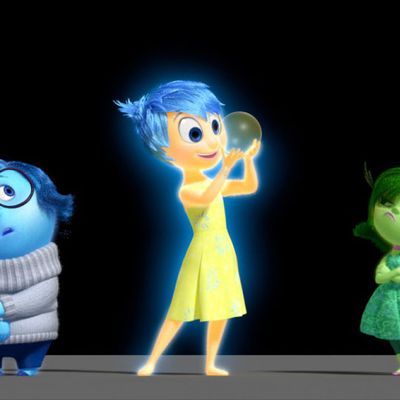
In 2009, NPR writer Linda Holmes had a simple request for Pixar, one she put forth in an article titled, “Dear Pixar, From All the Girls With Band-Aids on Their Knees.” The entreaty? “Please make a movie about a girl who is not a princess.”
At that point, Pixar hadn’t made a movie that starred a girl at all. Yes, there were important female characters in many of the company’s most beloved films, like Jessie from Toy Story and Dory from Finding Nemo, but none who could truly be considered the lead of her own movie. Most Pixar films unequivocally starred a male character — or often two, since the studio has made several buddy comedies. “The story is never ‘a girl and the things that happen to her,’” wrote Holmes, “the way it’s ‘a boy and what happens to him.’”
That will soon change, and in a big way. After delivering its first female-led film with 2012’s Brave, Pixar brass came down to Los Angeles last night to preview their big title for next year, Inside Out, which is completely princess-free. It takes place in the mind of a little girl named Riley, but she’s not exactly the lead; instead, thanks to the ingenuity of Pixar, Riley is more like the setting.
The film’s real protagonist is Joy (voiced by an effervescent Amy Poehler), one of five emotions who steer Riley through life via a control center in her mind that’s akin to the bridge from the Starship Enterprise. Joy and her cohorts — including Fear (Bill Hader), Disgust (Mindy Kaling), Anger (Lewis Black), and Sadness (Phyllis Smith) — all work together to keep Riley emotionally balanced, and for the first 11 years of her life, the primary influencer is Joy, as evidenced by Riley’s sunny demeanor.
But as adolescence sets in, Joy finds her lead role usurped. Suddenly, Sadness wants to pipe in at inappropriate times — coaxing Riley to cry during her first day at a new school, for instance — and as the two emotions jostle for control, both of them fall into the deepest reaches of Riley’s mind and have to work their way back. Meanwhile, left to their own devices, Fear, Disgust, and Anger collude to transform Riley into a moody preteen.
“The whole story sparked from watching my daughter grow up,” said director Pete Docter, who also helmed Monsters Inc. and Up. As his daughter Ellie grew older, she started to lose the natural joy that once seemed so inherent in her personality, and as Docter mused on why that was, he hit upon his movie. “Also, as we did our research, psychologists told us there is no one more emotionally attuned than a 12- to 16-year-old girl,” he told Vulture after the presentation. “They are just totally dialed in to read everything — for whatever reason, it’s sociologically true.”
The real spin on the Pixar formula comes when Joy and Sadness have to work together to make their way back into Riley’s mind; unless you count Merida’s misadventures with her non-verbal, transformed mother in Brave, Inside Out qualifies as Pixar’s first female buddy comedy. Producer Jonas Rivera says that decision came naturally. “Joy just felt like she’d be female,” he said. “It wasn’t something that we engineered or overthought — it just felt right to us.”
Docter concurred. “It’s not like I set out to make a girl-power movie,” he told Vulture. “But I think this story and the subject matter really speaks to that.”
And it will likely speak to millions of little girls, too. I thought of Holmes as Docter played the first five minutes of his movie, a fleet and touching montage that emotionally rivals what he accomplished in the famous first act of Up. As Inside Out begins, Riley is born, and Joy enters her mind for the first time, awed at what she beholds. As Riley grows, playing games with her parents and roaming around the house as a toddler, Joy stores those memories in glowing marbles, each of which coaxes elements of Riley’s personality to come to the fore.
One of those memories flashes by in a flash, but it’s pivotal: Tottering around on an icy lake with her parents, young Riley inadvertently hits a hockey puck into a nearby net, scoring an accidental goal. Joy files that experience away as a treasured memory, and Riley’s interest in sports grows commensurately; moments later in the montage, when we see an older Riley, she’s skidding across the ice again, this time equipped not with a tiara and a scepter but with a hockey mask and a stick. She’s in the middle of a game, manipulating the puck like a master, driven as can be. In an instant, you know: This is a girl with band-aids on her knees, and the movies (and Pixar) are all the richer for it.




